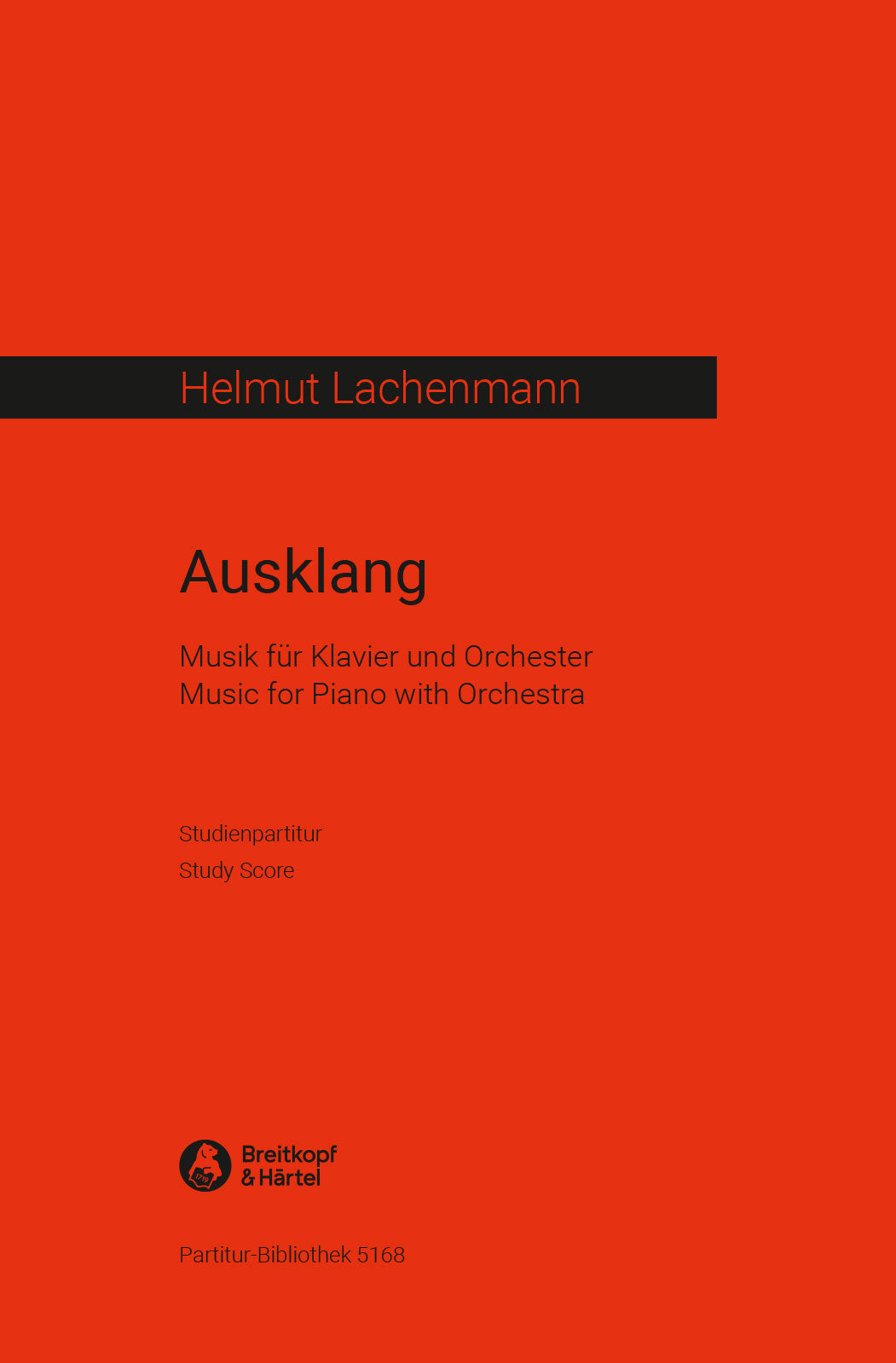Lachenmann: Ausklang
Expected to ship in 1-2 weeks.
- Composer: Helmut Lachenmann (1935-)
- Format: Study Score
- Instrumentation: Piano, Orchestra
- Work: Ausklang (1985)
- ISMN:
- Size: 9.1 x 13.8 inches
- Pages: 192
Description
The wish to defeat gravity, to outsmart it, or at least to simulate situations of conquered gravity, can find its pendant in the many attempts to delay the fading away of sound which has been put into vibration by an impulse - or instance the sound of a piano. The history of piano music, and not just since Romanticism, is almost completely the history of such techniques. Though these play an important role in my compositions, I am more interested in how the possibilities are changing. Pianistic models derived from fingering techniques, organised as mechanical processes initially only meant to move the strings, the fading away of which should be prevented by several violent interventions; severe rhythmicised processes of construction and deconstruction; filtering, sudden integration of totally different categories of perception, etc: such smuggled models created their own dynamics.
Also essential is the possibility of transfering the initial pianistic type (attack impulse, figuration, form, metamorphosis, but also reversibility and firmness) to the orchestra, to separate characteristic orchestral groups as if to create a superpiano. The solo instrument thus becomes only part of the whole. As signposts in this material landscape, there are raw basic forms such as the unchanged echo, the pure sound, but also more complex forms such as "false echo", the "filtered cantilene" and finally also "martellato" fields covering their own echo or being swallowed by it . Simultaneously, there is a harmonic image: harmonics orientated towards simple and aggregate forms, unison sound (the orchestral version of the string choirs of the piano), but also a second, the simple tonally unresolved interval. All these are coordinated in view of the fading processes which have to be hindered on a small and a large scale, expressively emptied and loaded anew. The music thus goes through situations which – continuing, contrasting or changing in quality originate from one another. It appears to move away from the initial idea, becoming more and more independent, only to reach that same idea again, recognizing themselves as a giant cantibile, and subject themselves to it.
(Helmut Lachenmann, program notes for the Huddersfield Festival 2000)
Publishers use a lot of words to describe what they sell, and we know it can be confusing. We've tried to be as clear as possible to make sure you get exactly what you are looking for. Below are descriptions of the terms that we use to describe the various formats that music often comes in.
Choral Score
A score for vocalists that only contains the vocal lines. The instrumental parts are not there for reference. Generally, cheaper than a vocal score and requires multiple copies for purchase.
Facsimile
Reproductions of the original hand-written scores from the composer.
Full Score
For ensemble music, this indicates that the edition contains all parts on a single system (there are not separate parts for each player). In larger ensembles, this is for the conductor.
Hardcover
Hardbound. Generally either linen-covered or half-leather.
Orchestral Parts
Similar to a wind set, this is a collection of parts. In the case of strings, the numbers listed are the number of copies included, though generally these are available individually (often with minimum quantities required).
Paperback
When publishers offer multiple bindings (e.g. hardcover) or study scores, this is the "standard" version. If you're planning to play the music, this is probably what you want.
Performance / Playing Score
A score of the music containing all parts on one system, intended for players to share. There are not separate parts for each player.
Set of Parts
For ensemble music, this indicates that there are separate individual parts for each player.
Solo Part with Piano Reduction
For solo pieces with orchestra, this is a version that contains a piano reduction of the orchestra parts. For piano pieces, two copies are typically needed for performance.
Study Score
A small (think choral size) copy of the complete score meant for studying, and not playing. They make great add-ons when learning concertos and small chamber works.
Vocal Score
A score prepared for vocalists that includes the piano/organ part or a reduction of the instrumental parts.
Wind Set
For orchestral music, this is a collection of wind and percussion parts. The specific quantities of each instrument are notated.
With Audio
In addition to the printed music, the edition contains recordings of the pieces. This may be an included CD, or access to files on the internet.
With / Without Fingering (Markings)
Some publishers prepare two copies - a pure Urtext edition that includes no fingering (or bowing) suggestions and a lightly edited version that includes a minimal number of editorial markings.



